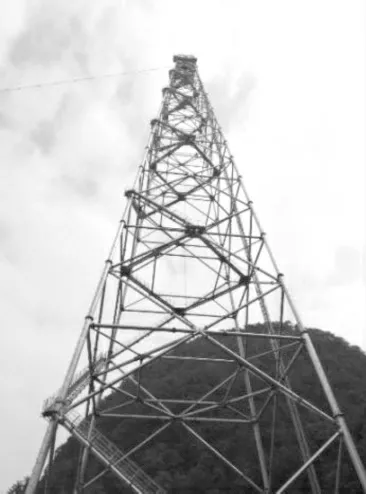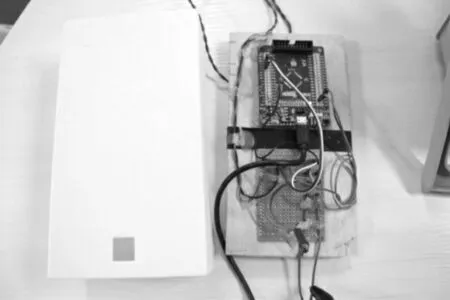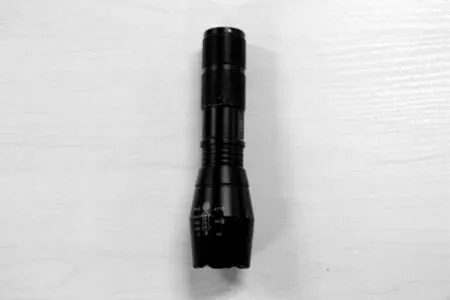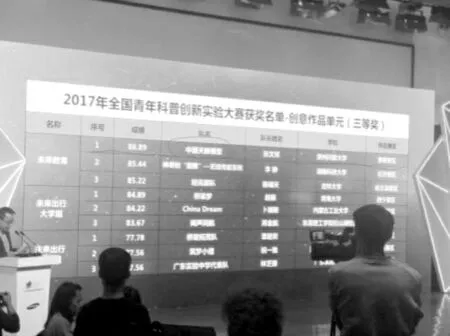Technical Research on Model Structure of Chinese“Sky Eye”
2018-05-13ZhangWenyongXuJieWangAnzhiYangTaiming
Zhang Wenyong,Xu Jie,Wang Anzhi,Yang Taiming
(1.Engineering Training Center of Guizhou Minzu University,Guiyang,Guizhou Province 550025;2.School of Mechatronics Engineering of Guizhou Minzu University,Guiyang,Guizhou Province 550025)
Abstract:Chinese Sky Eye (hereinafter referred to as Sky Eye)is mainly used to receive and analyze electromagnetic signals which are invisible to the human eye for the useful space message.However,the Sky Eye model is designed primarily to allow non-professionals to understand the process Sky Eye receives electromagnetic signals from the universe.The model helps visible light to simulate the electromagnetic signal received by Sky Eye.Adopting reflective panel to converge the visible light into the analog feed and receiver system,people convert the received visible light into an electrical signal through the photosensitive resistance and related circuits.At last,the electrical signal will be transmitted through the wire to display at the analog data center.If the reflective panel fails to reflect visible light to the position of the photosensitive resistance,the analog measurement and control system can be adjusted by the infrared remote control to make the feed bin reach the reflection point of visible light.
Keywords:visible light;reflective panel;photosensitive resistance;electrical signal
I.Introduction
Sky Eye, referring to Five-hundred-meter Aperture Spherical radio Telescope,is the world's largest single-aperture radio telescope[1].It was proposed by Dr.Nan Rendong,a famous Chinese astronomer,in 1994.After more than ten years work,Dawodang depression,a natural basin in Pingtang County, Guizhou Province, southwest China, was selected as the construction site of Sky Eye from the several hundred candidate locations.The project was completed on September 25,2016.Its surface area is equivalent to 30 standard football fields[2],and the frequency range is between 70GHz and 3GHz.As the world's largest single- perture radio telescope,technical performance of Sky Eye will remain world-class in the next 20-30 years.It is mainly applied to study pulsars and establish pulsar timing arrays,to reproduce early images of the universe and black holes devouring small celestial bodies and evolution of stars,to search for alien civilizations,and to detect gravitational waves, etc.[3].Since the completion of the construction,countless tourists at home and abroad attracted to visit the Sky Eye.As it is mainly used to receive electromagnetic waves that the human eye can't see in the universe, most visitors only stand on the observation deck and simply watch the appearance structure instead of really understanding the whole principles of signals receiving and processing.Sky Eye model mainly solves this problem with an aim to enable non-professionals simply and clearly watch the entire process of information processing.
II.Overall Structure
Picture 1 is the actual Sky Eye structure,and Picture 2 is the Sky Eye model.Judging from its appearance,Sky Eye structure generally consists of active reflection panel system, measurement and control system, feed support system, feed and receiver system,and the observation base.Picture 2,the model was designed to simulate Picture 1,mainly including analog system of reflective panel,analog measurement and control system,analog feed and receiver system,analog feed support tower system,analog data processing center,star signal generation simulator,etc.It uses visible light to simulate the electromagnetic signal generated by the stars.

Picture 1 Sky Eye Structure

Picture 2 Sky Eye Model
(i)Analog System of Reflective Panel
Picture 3 shows the active system of reflective panel of Sky Eye,and Picture 4 shows the simulated reflective panel system.The active system of reflective panel is made up of 4,450 reflective surfaces with a side length of about 11 meters.The total area is equivalent to 30 standard football fields.The shape is like a huge pot.According to Yan Jun,director of the National Astronomical Observatory of the Chinese Academy of Sciences,“active system of reflective panel adopts a light-weight cable drag mechanism and parallel robot to achieve high-precision positioning of the receiver,which is one of the three independent innovations of Sky Eye”.The analog system of reflective panel is modified with a 1.5KW solar cooker with good light reflection and convergence effects.It is mainly used to simulate the process of the active system of reflective panel for converging electromagnetic signals to the position of the feed bin and observe the convergence effect taking advantage of visible light.

Picture 3 Active System of Reflective Panel of Sky Eye

Picture 4 Analog System of Reflective Panel
(ii)Analog Measurement and Control System
Picture 5 shows the analog measurement and control system module.In the process of receiving the electromagnetic signals,the feed and receiver system needs to adjust the position of the feed bin at a specific time in order to maximize the amount of information received by the electromagnetic wave.The feed support system pulled by six special steel cables can move spherical doom from 140 to 180 meters above the active system reflective panel,207 meters in diameter.Therefore,the accuracy of the real-time position of the feed bin counts for much.The work with the control system is primarily to determine the real-time location of the feed bin.The measurement and control system is a measurement network c onsisting of more than ten high-precision reference stations.The laser tracking system is used to track the position of the feed bin in real time.The analog measurement and control system uses the STM32 microprocessor as the controller for the analog hoist on each feed support tower.The infrared remote control technology allows one or more of the analog hoist to drag the feed hopper to the desired position.

Picture 5 Analog Measurement and Control System Module
(iii)Analog Feed and Receiver System
The feed and receiver system is mainly used for receiving the electromagnetic signal concentrated by the reflective panel.After pre-processing these signals,it will send the results to the analog data processing center.The receiving frequency ranges from 70 MHz to 3 GHz.As shown in Picture 6,the analog feed and receiver system uses a feed bin printed by a 3D printer as an external structure.According to Picture 7,a photosensitive resistance is used as an analog receiver.The resistance value remains unchanged when the photosensitive resistance is illuminated by constant lights.If the light changes suddenly,the photosensitive resistance changes rapidly.With the characteristic of the photosensitive resistance, the corresponding processing circuit can be designed to realize the collection of the optical signal.

Picture 6 Analog Feed and Receiver System

Picture 7 Photosensitive Resistance as Analog Receiver
(iv)Analog Feed Support Tower System
Picture 8 is a feed support tower and Picture 9 is an analog feed support tower.The feed support system consists of six support towers,hoists and guides for spatial position adjustment as well as precision adjustment robots for fine adjustment.The analog feed support tower system adopts a support tower structure with a universal angle to build six support towers,a geared motor to produce a hoist,and a 3D printer to print feed bin.

Picture 8 Feed Support Tower System

Picture 9 Analog Feed Support Tower System
(v)Analog Data Processing Center
The data processing center is mainly used to process the universal electromagnetic wave data collected by the feed and receiver systems in real time.The huge electromagnetic data is calculated and analyzed by the supercomputer to extract useful information.The analog data processing center is mainly composed of a processing circuit of photosensitive resistance and an oscilloscope.Picture 10 is a processing circuit of photosensitive resistance that converts the optical signal received by the photosensitive resistance into a standard digital signal and sends it through the STM32 microprocessor to display on the oscilloscope.Picture 11 shows the oscilloscope displaying real-time information.

Picture 10 Processing Circuit of Photosensitive Resistance

Picture 11 Oscilloscope Displaying Real-time Information
(vi)Star Signal Generation Simulator
There are countless stars in the space that can generate electromagnetic waves which are invisible to the human eye.The earth is in the universe,and there are countless electromagnetic waves reaching the earth at all times.Therefore,Sky Eye can receive and process the electromagnetic signals of the universe all day.The Sky Eye model is mainly used to explain to non-professionals the entire process from the generation of electromagnetic waves to the data arriving at the data processing center.The use of visible light instead of electromagnetic waves that cannot be seen by the human eye has a good display effect.The Sky Eye model uses a flashing high-intensity flashlight as a star signal generation simulator,which makes the signal more intuitive and convenient for transmission and observation.Picture 12 shows the star signal generation simulator.

Picture 12 Star Signal Generation Simulator
III.Achievements
The Chinese Sky Eye Model,recognized by such units as the Guizhou Science and Technology Museum and Guizhou Dream-building Works Education and Culture Development Co.,Ltd.,has a good demonstration effect,involving in the popular science promotion activities of the relevant units.It participated in National Youth Science Innovation Experiment and Work Competition sponsored by the Department of Science Popularization of the China Association for Science and Technology and Central School of the Communist Youth League in December 2017 and won the first prize of the Guizhou Division and the third prize of the National Finals.Picture 13 shows students organized by Guizhou Dream-building Works Education and Culture Development Co.,Ltd.listen to the principle of the Sky Eye.Picture 14 shows the awards.

Picture 13 Students Visiting the Sky Eye Model

Picture 14 Awards&Honors
杂志排行
中阿科技论坛(中英文)的其它文章
- 中国天眼模型结构的技术探究
- 基于应用技术实现语言处理研究
- Study on the Law of the Development Height of Water Flowing Fractured Zone in Shaanxi Guojia River Coal Mine
- 宁夏枸杞产业的SWOT 分析与发展策略
- The Potentials,Challenges and Path for Achieving Science and Technology Cooperation between China and Arab States under the Background of the Belt and Road Initiative
- SWOT Analysis and the Development Strategy of Goji Berry Industry in Ningxia
